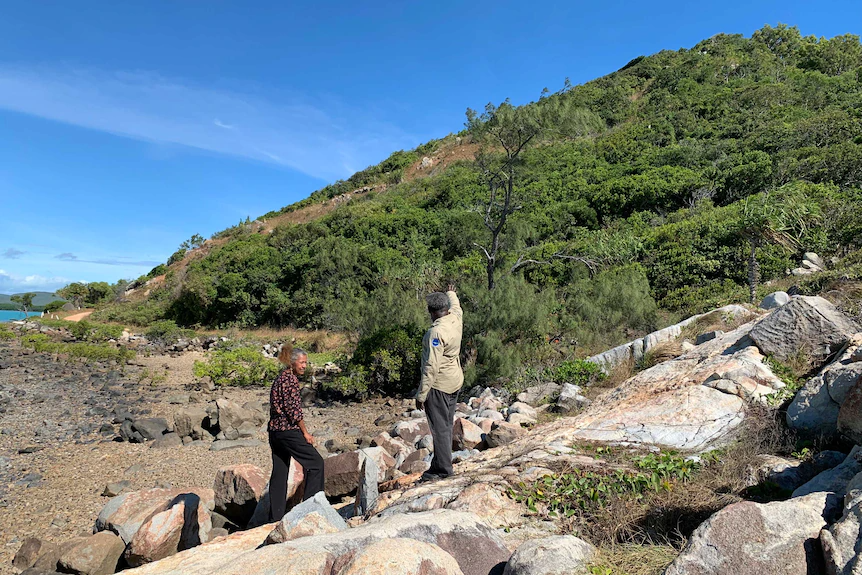NB. The authors acted for the applicants in the injunction proceedings and in the appeal, where Mr Graham Carter provided native title advice.
Snapshot
- Reports of damage and destruction of culturally significant Aboriginal sites and artefacts has led to debate about the most appropriate legal tools for their protection.
- A recent success story from the Torres Strait demonstrates that the courts will step in to provide urgent protection when a culturally significant site is under threat from development.
- The case also establishes that under the Native Title Act, proposed future acts can be stopped if the court is satisfied there is a real potential of mminent harm.
Recent examples of the damage or destruction of culturally significant Aboriginal sites and artefacts has led to a debate about the most appropriate legal tools for their protection. One recent success story wherein a creation 'story site' on Prince of Wales Island (Muralug) in the Torres Strait was protected from a safe harbour development, demonstrates that the courts are willing to step in and grant urgent protection.
Background
In 2001, the Kaurareg people obtained a determination granting native title rights and interests over an area which included Prince of Wales Island (Kaurareg People v State of Queensland [2001] FCA 657 ('Kaurareg determination')).
An Indigenous Land Use Agreement ('ILUA') was also entered into between the local Torres Shire Council ('TSC') and the Prescribed Body Corporate, being the Kaurareg Native Title Aboriginal Corporation RNTBC ('KNTAC') on 9 October 2000. The 2001 determination related to land above the high watermark within the determination area - i.e. it did not include sea rights which remain the subject of current proceedings in the Federal Court ('the Sea Claim') (Isaac Savage & Ors on behalf of the Kaurareg People #2 v State of Queensland QUD10/2019).
Proposed development
In 2019, the TSC had approved road improvement works, as well as its own development application for a safe landing marine facility in the vicinity of an important Indigenous story site at Waubinin Mabauzi Lag and Waubinin Malu, otherwise known as Pearl Harbour. This was despite the objections of the KNTAC and others including a member of the Sea Claim group, Milton Savage. The TSC gave notice that certain works would imminently commence in the vicinity of the story site.
Warrior Waubin and the story behind the story site
The mythic Kaurareg warrior, Waubin, is believed to have travelled from central Australia to the Torres Strait and resided on Muralug with a number of his Ippi (wives) and roamed the island hunting, and from time to time fighting with other warriors. One key Waubin story relates to his final battle and is connected to an area known as Waubinin Mabauzi Lag (Waubin walked down) and Waubinin Malu (the Sea of Waubin) - collectively considered 'the story site'. Waubinin Malu is also known as Pearl Harbour.
When Waubin's leg was cut off in battle, his blood flowed down the hill at Waubinin Mabauzi Lag and into the sea at Waubinin Malu. There is a reddish tinge still visible at Waubinin Mabauzi Lag where vegetation will not grow, and there are fast flowing tides at Waubinin Malu created by Waubin when he walked into the sea that protects Muralug.
Application for injunction
Although there had been correspondence between the TSC and legal representatives of the KNTAC regarding the cultural significance of Waubinin Mabauzi Lag and Waubinin Malu, the fact that the works for the safe landing marine facility were now imminent meant the only real option left available was to make an urgent application for an injunction to prevent the commencement of works.
The applicants were the KNTAC and two senior Kaurareg Elders who agreed to be personally involved in the proceedings, Mr Milton Savage, Chairman of the KNTAC and member of the Sea Claim group and Ms Enid Tom, former Deputy Chairperson of the KNTAC, current KNTAC board member and landholder. The material was prepared on an urgent basis with the injunction hearing commencing at 5:03pm on that Friday, 17 May 2019, in the Federal Court in Brisbane before Logan J (QUD315/2019).
There were two main questions before the Court:
- Should the injunction be refused on the basis that damages were an adequate remedy?
- Should the KNTAC and the Kaurareg Elders be required to give an undertaking as to damages?
On the first question, Logan J stated that:
"of particular concern... is the prospect of irretrievable damage to an area which means something to native title holders and therefore should mean something generally. And damages are never going to be an adequate remedy for that, are they?"
(Transcript p 13, lines 3-5)
The responding submission made on behalf of the TSC was that:
'the common law has been awarding damages for torts such as trespass for centuries...'
(Transcript p 13, lines 8-10)
The view of Logan J was:
"It's just that native title has particular unique features... it's beyond emotional, a spiritual connection which has meaning to the native title holders. And in British jurisprudence... we say damages can be an adequate compensation. And the Native Title Act contemplates compensation in respect of particular extinguishment that happened after the Racial Discrimination Act but before we were enlightened about the common law by Mabo and then the Native Title Act."
(Transcript p 13, lines 11-20)
The Court rejected any proposition that damages were an adequate or appropriate remedy for a potential future act that might damage or destroy a culturally sensitive site, as in this case. The applicants were not in a position to provide an undertaking as to damages where the respondent had suggested the costs of delaying would be quantified as $14,500 per day. (Transcript p 13, lines 41-45)
The applicant's position was that whilst an undertaking as to damages would usually be appropriate when seeking an injunction, the current matter included a 'public interest' aspect that needed to be considered when looking at the balance of convenience. The applicant's submission was that in the current circumstances (where the applicants were seeking an interim injunction), that the balance of convenience would also consider the public interest aspect. (Transcript p 6, lines 40-49)
Logan J made orders including:
- restraining the respondent from undertaking public works within the relevant area (until 3 June 2019); and
- requiring the respondent to provide the applicants with particulars as to the location of, and nature of, the proposed public works.
The injunction provided the applicants with the 'breathing space' to bring an appeal in the Queensland Planning and Environment Court ('P&E Court').
Planning and Environment Court Appeal
On 3 June 2019, the KNTAC and Milton Savage appealed, seeking orders that the development application (the subject of the appeal) be refused. The appellants' grounds of appeal included the contention that the TSC development application was not compliant on the following grounds:
- Cultural Heritage - the proposed development did not conserve the cultural heritage and significance of the land both above and below the high watermark for the benefit of the community and future generations.
- Biodiversity - the proposed development did not ensure that matters of environmental significance were valued and protected, and the health and resilience of biodiversity was maintained or enhanced to support ecological process.
- The proposed development did not appropriately conserve and consider matters of Aboriginal cultural heritage to support the requirements of the Aboriginal Cultural Heritage Act 2003 (Qld).
- The application did not comply with relevant provisions of the Torres Shire Council Planning Scheme relating to Desired Environmental Outcomes for Healthy Environment.
The benefit of commencing the proceedings in the P&E Court was that under s 72(2) of the Planning Act 2016 (Qld), those proceedings effectively operated as a statutory stay/injunction pending the determination of the appeal. The appellants filed and served their statements of lay evidence in accordance with the Courts directions on 29 January 2021. On 18 February, the P&E Court made orders allowing the appeal and refusing the development application which was the subject of the appeal.'
Effectively, these orders were made by the Court with the consent of the applicants; the TSC and the State of Queensland, who had become involved as a co-respondent by-election.
Culturally significant sites can be protected
Important takeaways from the Kaurareg parties' success in protecting their creation story site are:
- The courts will step in to protect a culturally significant site from damage or destruction; and
- Proposed future acts under the Native Title Act can be stopped if the court is satisfied there is a real potential of imminent harm.
As Logan J said in the injunction judgment when commenting on particular associations as between the Kaurareg people and the land on Muralug:
'Those associations are not to be diminished in terms of their importance by a submission ... that damages may be an adequate remedy. In relation to the bundle of rights represented by native title, and the particular associations and emotional and spiritual ties which underpin that bundle of rights, money may never be an adequate compensation for what may be an invalid future act... for something that will be destructive of one or more of the bundle of rights that comprise native title. In this... case, one of that bundle of rights is an obligation to protect sacred site areas.'
(Kaurareg Native Title Aboriginal Corporation RNTBC v Torres Shire Council [2019] FCA 746 at [10])
The successful protection of the Kaurareg creation story site gives hope for the protection of other significant cultural heritage sites so that these sites, some of which are older than the pyramids in Egypt, can be treasured by current and future generations.


